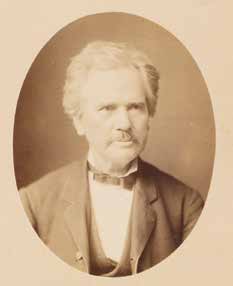PANORAMA OF HYDE PARK, c.1893
JOHN RAE
watercolour on photographs on paper on stretched linen
21.0 x 144.5 cm
inscribed upper centre: 1842
inscribed lower centre: Hyde Park / Drawn with Camera by John Rae Town Clerk
inscribed upper left: Supreme Court/ and Watch House, St. James Anglican Church, General Hospital/ (now Mint), Hyde Park Barracks
inscribed upper centre: Campanile, Seminary, St. Mary's R.C. Cathedral, Markers Mill, Gerard's Mill, Victoria Terrace/ John Alexander, Colonel Mundy, Judge Dickinson/ Craigend Mill
inscribed upper right: The Museum, Darlinghurst Jail, Sydney College/ (now Grammar School), Hyde Park Terrace, Lyons Terrace
inscribed centre right: Prosper De Mestre/ Liverpool St.
inscribed lower right: King/ The Flying Pieman
G. E. Friend, Sydney (label attached verso)
Sam Whitney, Sydney
John Williams, Sydney, 28 August 2011, lot A28
Private collection, Sydney
The Royal Australian Historical Society, Sydney
Supreme Court and St James Church, from Elizabeth Street, 1842, watercolour, 25.0 x 33.5 cm, Mitchell and Dixson Collections, State Library of New South Wales, Sydney
Hyde Park, St James Parsonage Dispensary, afterwards the Mint, and Emigration Barracks, 1842, watercolour, 26.0 x 34.5 cm, Mitchell and Dixson Collections, State Library of New South Wales, Sydney
Hyde Park, St Mary's Cathedral and Belfry, 1842, watercolour, 26.5 x 34.5 cm, Mitchell and Dixson Collections, State Library of New South Wales, Sydney
Hyde Park, windmills, Woolloomooloo, Darlinghurst Gaol, Museum, Sir E. Deas Thomson's house, 1842, watercolour, 26.0 x 33.0 cm, Mitchell and Dixson Collections, State Library of New South Wales, Sydney
Hyde Park, Museum, Darlinghurst Gaol, Sydney Grammar School, Burdekin's and Lyons' Terraces, 1842, watercolour, 26.0 x 34.0 cm, Mitchell and Dixson Collections, State Library of New South Wales, Sydney
Junction of Elizabeth & Liverpool Sts, Hyde Park, Burdekin's Terrace, Lyons' Terrace, outlet of Busby's Bore, 1842, watercolour, 26.0 x 34.5 cm, Mitchell and Dixson Collections, State Library of New South Wales, Sydney
1 JOHN.jpg

This 180-degree panorama of the open expanse of Sydney’s Hyde Park in the 1840s is unrecognisable to those familiar with the deeply shaded, tree-lined park we know today. It is a rare example of evolving technologies of visual reproduction used in the nineteenth century, by a man who was influential in the growth of Sydney over six transformative decades. Born and educated in Aberdeen, John Rae arrived in New South Wales in 1839 and was appointed by the newly formed Municipal Council as the city’s first full-time town clerk in 1843. From then until his retirement in 1893, he was actively involved in the shaping of the city, holding prominent public service positions.
Rae was also an enthusiastic participant in Sydney’s burgeoning cultural scene. He helped organise the first exhibition of the Society for the Promotion of the Fine Arts in 1847; painted; published; acquired art and a notable library; and was a popular lecturer at the Mechanics’ School of Arts, speaking on topics ranging from poetry to photography.1 He was well versed in this latter topic, using a home-made portable camera obscura from the 1840s, and practicing as an early proponent of photography from the 1850s. He even built a camera obscura on the roof of his house, Hilton, in Darlinghurst, as was reported in the Sydney Morning Herald, which published lengthy accounts of his lectures on this new technology in 1855.2
1 JOHN 2.jpg

The principles of the camera obscura, by which a scene can be projected onto a surface through a pin-hole or lens, had been known for centuries and was employed by many artists as sketching guides. Rae used these projections as the basis for accurately rendered, multi-sheet watercolour panoramas of numerous locations in Sydney as well as Newcastle, Wollongong and pastoral vistas. Many of these watercolours are held in the State Library of New South Wales collection, including the sheets that make up his view of Hyde Park from Elizabeth Street, capturing Sydney-siders riding, promenading and playing multiple cricket matches.3 Although the watercolours are dated 1842, some of the buildings depicted were not constructed until later in that decade and it seems likely that Rae signed them retrospectively.4 This tallies with the knowledge that he returned to his earlier art in the 1880s and 1890s, exhibiting in the Calcutta International Exhibition (1883) and again, at the Melbourne Centennial International Exhibition (1888 – 89).
Around 1893 a selection of Rae’s early watercolours were photographed and published in album format; he also hand-coloured a number of these photographs. Such is the case here: six photographs of the Hyde Park set have been carefully aligned and pasted together, overpainted with watercolour such that the underlying photograph can barely be seen. Buildings have been carefully labelled and the central inscription notes that they were ‘drawn with camera’ by Rae.5 Further examples of these hand-coloured photographs are held in the City of Sydney art collection, in a set gifted by the artist to a friend.6 Upon his death in 1900, an appreciative obituary noted that ‘many interesting relics of Old Sydney have been preserved from forgetfulness by Mr Rae’s brush and pencil.’7
1. The Mechanics’ School of Arts was the forerunner to the Sydney Technical College, now part of TAFE New South Wales.
2. ‘Photography. Being some extracts from a lecture delivered by John Rae’, The Sydney Morning Herald, 14 September 1855, p. 8, and ‘School of Arts’ [Mr Rae’s second lecture], The Sydney Morning Herald, 20 September 1855, p. 2
3. DG V*/Sp Coll/Rae/1, DG SV*/Sp Coll/Rae/16-20, State Library of New South Wales
4. For example, the roof of the Australian Museum was not started until 1849.
5. The Australian Museum did not open until 1857, the same year that Sydney Grammar took over the buildings of Sydney College.
6. Margaret Betteridge, Sydney Town Hall: The Building and its Collection, Council of the City of Sydney, 2nd edition, Sydney, 2016, pp. 138 – 39
7. The Sydney Morning Herald, 17 July 1900, p. 4
ALISA BUNBURY
